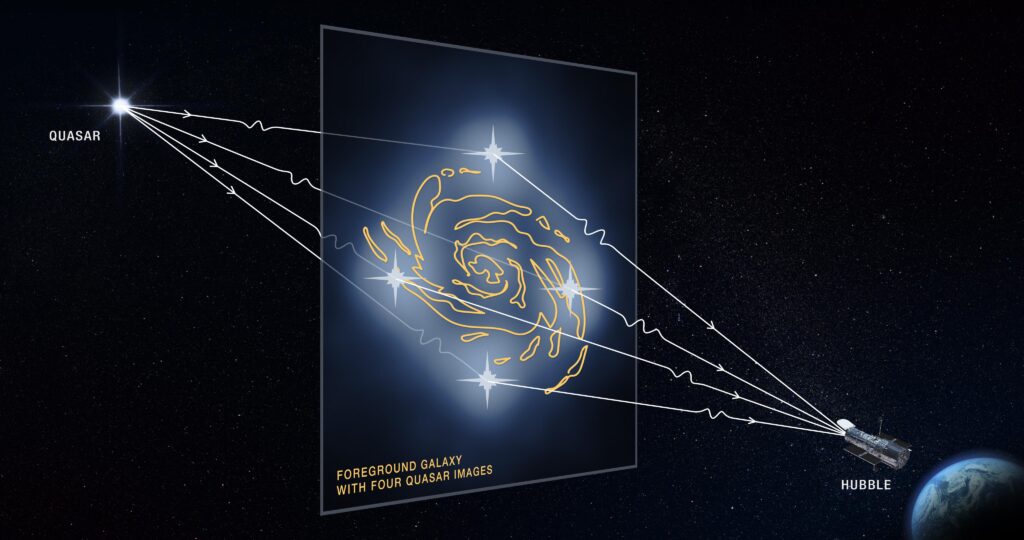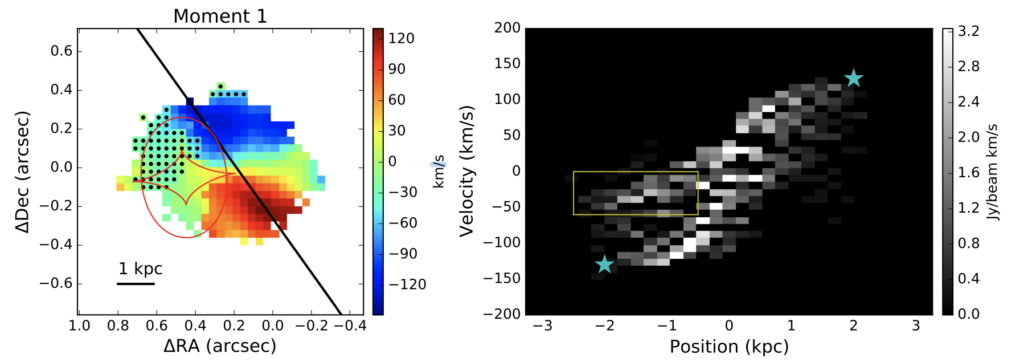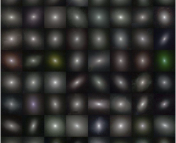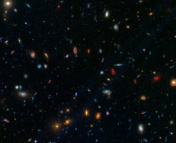Authors: Minghao Yue, Jinyi Yang, Xiaohui Fan, Feige Wang, Justin Spilker, Iskren Y. Georgiev, Charles R. Keeton, Katrina C. Litke, Daniel P. Marrone, Fabian Walter, Ran Wang, Xue-Bing Wu, Bram P. Venemans, and Ann Zabludoff
First Author’s Institution: Steward Observatory, University of Arizona, Tucson, AZ
Status: Accepted by The Astrophysical Journal [closed access]
The party starts at dawn, and you all are invited! You’ll be surrounded by new, up and coming stars, and a big fireworks show! There’s even a house of mirrors, where you can see a distorted, magnified version of yourself. And careful of the action in the very center, it’s bright and shiny, but if you get too close you could get ejected from the party entirely. Looking back, your view of the party might get a little warped, but it will surely be a bright point. Oh, and it’s hosted by a luminous quasar (z = 6.5) that is powered by a supermassive black hole–you can’t miss it!
Into the cosmic house of mirrors
In today’s paper, the authors target a gravitationally lensed quasar and its host galaxy in the early Universe, the first of its kind to be observed so far back in spacetime (during cosmic dawn). Gravitational lensing occurs when mass along the observer’s line of sight distorts light before it reaches the observer, turning the Universe into a sort of cosmic house of mirrors. During the process, some clump of mass (in this case, another galaxy) in the foreground magnifies and warps the light — a consequence of general relativity — coming from the background object (here, the quasar and its host galaxy). To get a sense of how this works, see Figure 1 below, or check out the iOS app, GravLens3!

This lensing is like having an extra, natural telescope amplifying the signal and providing a higher resolution image. For this dataset, the galaxy’s light is boosted by about 4 times, and stretched out enough to resolve structure on small scales. But the amplification doesn’t come for free — the lensing also manipulates the image from the background source. While the lensed object is actually a single blob, the lensed image we get is stretched out and appears multiple times, depending on how the mass of the foreground lens is distributed and positioned with respect to the background lensed object.
Hyper-starbursting and supersized
Quasars, some of the brightest and most extreme objects in the Universe, are found in galaxies during a temporary mega-bright phase (see this Astrobite for more about how they grow). During this phase, their central supermassive black holes vigorously funnel in material, building a disk of hot, luminous material around it and ejecting material along energetic jets. While quasars are bright and easy to detect, the galaxies that host and fuel them are often hidden behind the shining quasar in their active centers. However, if we can peer behind the quasar and target the gas and dust in the host galaxy, we can better understand the nature and origin of the galaxy-quasar system.
Today’s authors use millimeter wavelength observations from the Atacama Large Millimeter/submillimeter Array (ALMA) to measure the host galaxy’s dust and [CII] emission. [CII] is a molecular emission line that is commonly used to trace the motions and content of gas, the main fuel source for luminous galaxies. These observations provide clues about the structure, motions, and star formation activity within the host galaxy. After building a model of the lens in order to disentangle the multiple images into the original single source, they were able to confirm their previous lens model based on HST data (see the group’s earlier paper), and model the new ALMA data.
Based on their reconstruction of the background host galaxy (see Figure 2), the light profile looks like your everyday disk galaxy, and the kinematic tracers show a smooth velocity structure. These clues together suggest that the host galaxy is a regular, rotating disk, like a vinyl spinning around on a record player. However, the dynamics are a bit more complicated, as the galaxy doesn’t appear to be symmetric along its axes, nor a thin disk — so, not quite a vinyl on a record player. It could just be clumpy, but more likely it has a thick geometry and is more spheroidal than disky. Higher resolution observations are needed to better understand the complex kinematics going on here, which are a common feature of high redshift quasars.

The authors use motion and size measurements to estimate the mass and gas content of the galaxy. They find that gas–the fuel for star and quasar formation–makes up a high fraction of the galaxy’s mass. Given the smooth rotation, the gas reservoir likely was supplied by a previous merger or an ongoing inflow of gas from the galaxy’s surroundings. Further, as the galaxy is gas rich, it also hosts intense star formation at a rate of ~1560 M☉/year (the MWG has a moderate star formation rate of 1-2 M☉/year), a common property of high redshift quasars. Tracing this vigorous star formation throughout the galaxy, the authors find that the galaxy forms stars extremely efficiently, at just about the maximum possible rate!
The kinematics also provide key measurements that can be used to estimate properties of the galaxy’s supermassive black hole. In the local Universe, the mass of a central supermassive black hole and the mass of its host galaxy follow a simple positive relation. In this paper, the authors describe their galaxy’s black hole as oversized, as it’s relatively large compared to the host galaxy. This has been found for other similar distant quasars, and suggests a fundamental difference in the coevolution of black holes within quasar systems and their host galaxies at early times.
A case study for the extreme
This system is the farthest lensed quasar in the Universe (redshift z = 6.5) discovered so far, among the very first stars and galaxies (to learn about the most distant quasar, which is non-lensed, check out this Astrobite.) It’s a pretty intense system, with an extreme star formation rate and efficiency, and an overly massive black hole in the middle — definitely a real rager of a party. Yet these extreme characteristics are not necessarily unique, and have been observed for the small sample of (non-lensed) quasars at cosmic dawn with ALMA. What makes this galaxy in particular so special is the fact that it’s gravitationally lensed, allowing for observations with much higher detail and signal. Moreover, the authors refer to this quasar as a case study for probing the nature, origin, and structures of quasars at cosmic dawn, and for understanding how supermassive black holes and their host galaxies co-evolve. Looking ahead to future studies, the authors hope to use higher resolution data to measure the influence of the central black hole more directly, confirm the geometry of the galaxy, and more precisely map its velocity field. Back into the cosmic house of mirrors at the party at dawn!
Astrobite edited by James Negus
Featured image credit: Viator/Spiegellabyrinth Berlin




